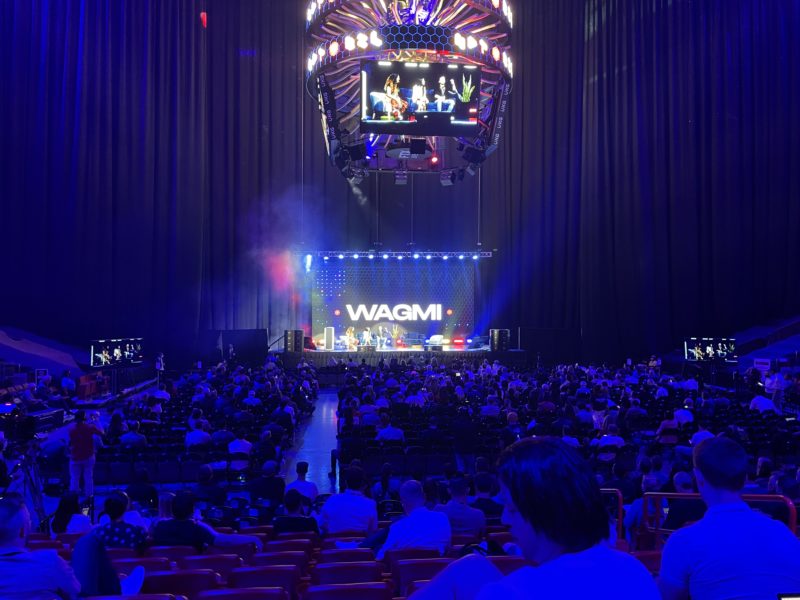Opinion
The virtual world
Are NFTs the answer to Jewish woes?
In Short
“What I love about NFTs,” said one young session panelist, “is that they give me an opportunity to be a true stakeholder in communities I care about.”
In 1998 I traveled with my family to Hangzhou, a 7,000-year-old center of art located in the northeast of mainland China. My mother, an artist herself, walked away from the visit with a traditional painting of the region’s misty mountains, which included the chomps (or signatures) of the picture’s past owners. These red marks, which float in the black and white inked sky, increase the art’s value.
I was reminded of the trip and this ancient practice while attending a conference on NFTs – a kind of cryptocurrency. Weirdly, this new trend reminded me of the ancient painting.


BZL-NFT Conference, Dec. 2021. WAGMI, which means “we are all going to make it,” is commonly used by the NFT community. Credit: Rebecca Dinar.
NFTs, or “non-fungible tokens,” are part of the metaverse – the virtual world. Often represented by art, each NFT is a digital asset defined by its verifiable and authentic ownership. Tracked by a digital underpinning – a blockchain – it’s the ownership (a kind of ledger) that produces value, just like the Chinese chomps on my mom’s painting.
It’s a hard concept to wrap your head around – but the payoff is clear. The former CEO of Twitter sold a tweet for $2.9 million. A video clip of a LeBron James slam dunk sold for over $200,000. What’s more, as each of these digital assets resell, everyone on the chain benefits and, by extension, becomes a micro-community. Think: rare coins collectors or Tesla owners.
One trailblazer in the NFT community building space is legendary entrepreneur Gary Vaynerchuk. He developed Vee-community, which has accrued more than $100 million in less than a year. Capped at 10,000 members, Vee-NFT holders benefit from curated access to Vaynerchuk and an opportunity to attend an exclusive conference – but more importantly they can resell their NFTs for a profit. One of the podcast hosts of “NFTs for Newbies” shared that they purchased one Vee-NFT for a whopping $3,000 and sold it for $40,000 a few months later. Last October, Christie’s Auction House sold five art works created by Vaynerchuk for his VeeFriends for just over $1.2 million.
Before I attended the NFT conference I knew nothing about cryptocurrency, and I was surprised by how much of the discussion was familiar. Investing in something “non-fungible” that aligns with personal beliefs is an idea central to philanthropy. NFTs just allow people to do it virtually, and for a profit.
“What I love about NFTs,” said one young session panelist, “is that they give me an opportunity to be a true stakeholder in communities I care about.” Her passions include empowering minority women and raising awareness for mental health issues. She buys NFTs to connect with like minded friends. “My NFT wallet,” she shared, “ensures that my digital identity matches my identity IRL [in real life].”
As I sat in the conference, I began to think about ways the Jewish world could use NFTs to solve some of its most vexing problems.
ENGAGE NEXTGEN: When you ask Jewish leaders what keeps them up at night, most will tell you they worry about engaging the next generation in Jewish life. Why not grow vibrant Jewish communities with NFTs? A survey conducted this year found that 23% of millennials collect NFTs as either a hobby or an investment. Jewish communal groups can meet them where they are and offer opportunities to affiliate Jewish-ly online.
EXTEND LEGACY GIVING: The Jewish world is excellent at selling naming rights. AIPAC, for example, sold the naming rights for its building to Mayer Mitchell, a real estate developer from Mobile, Ala., who legendarily helped steer the organization through the ‘80s and ‘90s. As an NFT, these rights could be made available virtually to anyone interested in walking in Mitchell’s footsteps. And, they could be bought and sold, providing financial gain to all involved, including AIPAC (the authentic and verifiable owner). A Jewish-legacy NFT would expand Mitchell’s bequest ensuring that both his name, and his gift, continue to flourish.
RAISE NEW FUNDS: Always looking for new opportunities to attract new funds to support growing agendas, Jewish organizations can mint their own NFTs. In a single month in 2021 more than half a million NFT artworks were sold bringing in more than $85 million. Imagine investing in NFT art to grow assets that benefit Jewish communal work IRL. The opportunity to further address rising antisemitism, food and housing insecurity, the needs of Holocaust survivors and so much more would be endless.
Does the Jewish communal world have the imagination required to seize the new opportunities presented in the virtual world? Last summer two tech-savvy rabbis joined forces to turn the Torah into NFTs by selling commissioned art that interprets each portion online. It’s not exactly what I am suggesting, but it’s a start.
Rebecca Dinar is a former Jewish communal professional.












